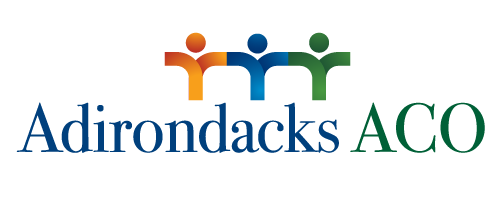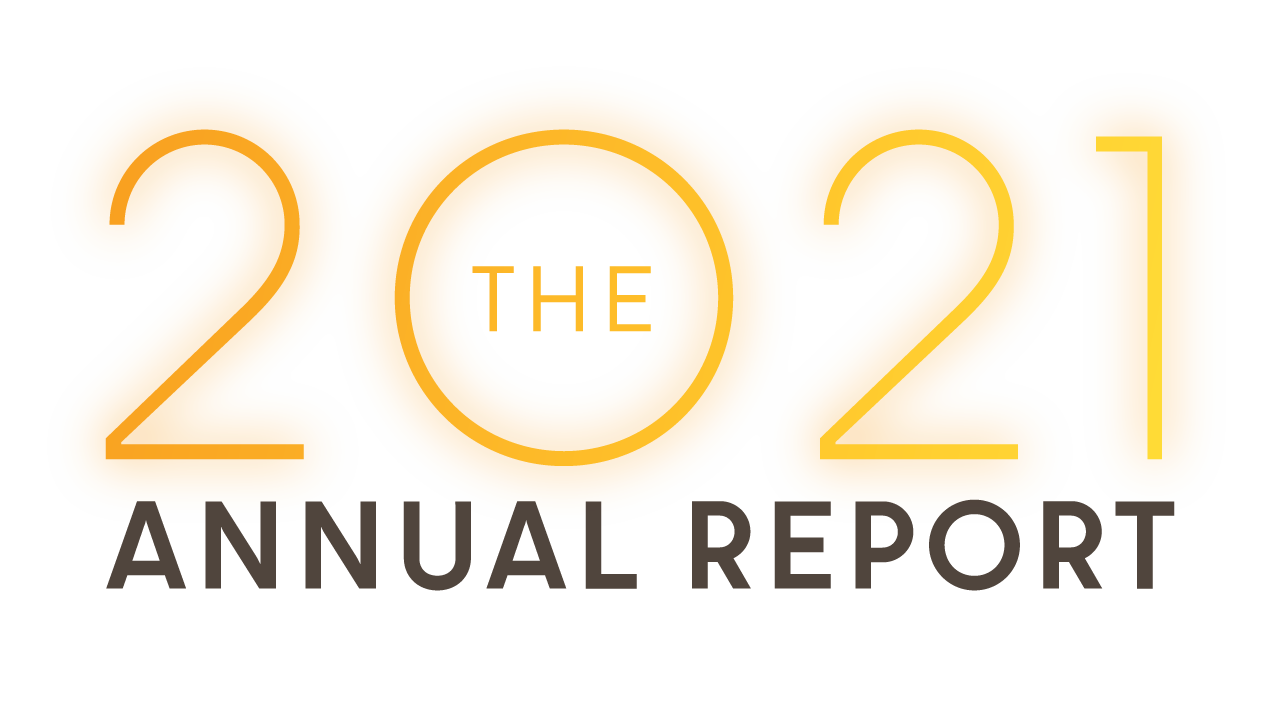
Better Community Care Through Collaboration
At the ACO, we are a provider-led entity that is working together to create the future we all want, with high-quality care, improved efficiency and outcomes, lower costs of care, and increased patient and provider satisfaction. Our vision for the future is a system that allows providers to spend time seeing and helping patients. We partner with health insurance companies, hospitals, independent medical practices, and the community to help ensure that patients get the care they need when they need it at the lowest possible cost overall. We provide our network partners, such as doctors and other providers, access to data, resources, and tools to improve patient health and ultimately lower the cost.
Together our goal is to make our community healthier and stay healthier by focusing on managing chronic illnesses, improving access to primary care, and behavioral health services in New York.
AIM of
Adirondacks ACO
We strive to ease the administrative burdens by providing our network partners access to data, resources, and tools to improve patient health.
Adirondacks ACO will continue to focus on impacting these areas to achieve high-value health care delivery in our region in 2022
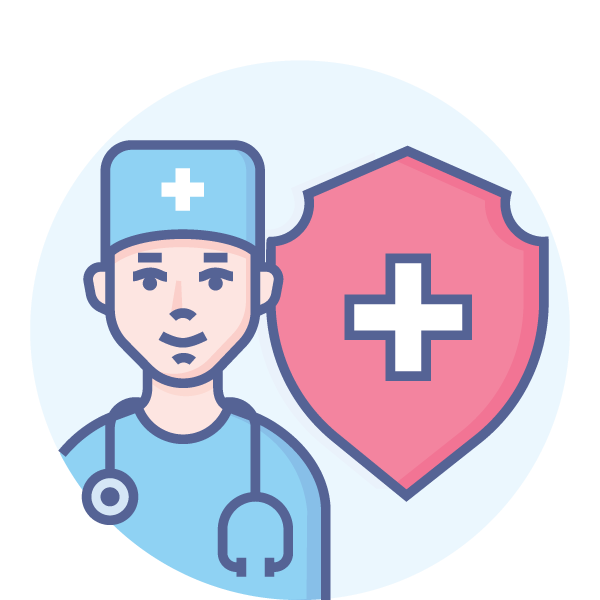
Provide our Network Partners with support that impacts care delivery
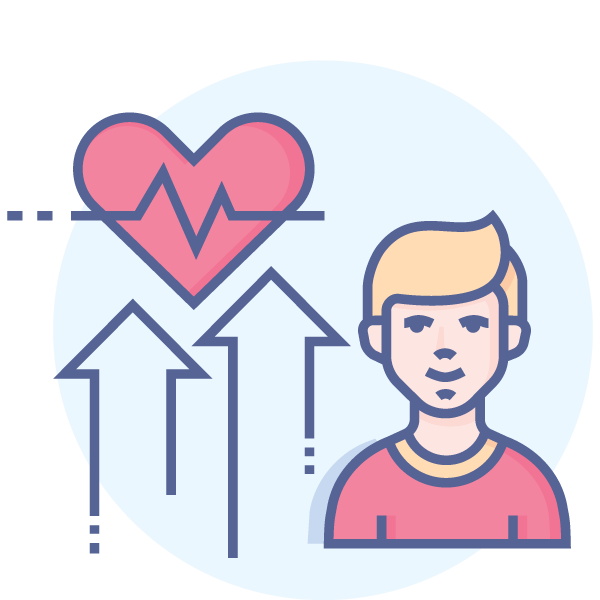
Boost the Overall Patient Experience

Improve the Health of our Communities
A Message From Our CEO, Eric Burton

Eric Burton
Interim Chief Executive Officer – Adirondacks ACO Chief Executive Officer – Adirondack Health Institute
The past few years have brought a host of changes and challenges to our daily lives. Nowhere are those challenges more evident than on the front lines of the healthcare delivery system. We are humbled to be working with such dedicated individuals and organizations who have done so much to care for our communities during this global pandemic.
Despite these challenges, we experienced several milestone accomplishments in 2021. After several years of a strong collaborative relationship between the Adirondacks ACO and Adirondack Health Institute, the organizations took another step to establish a sustainable population health vehicle for the region. Adirondack Health Institute became the sole member of the Adirondacks ACO in March of 2021.
Our shining moment was for the first time in the history of the Adirondacks ACO earning shared savings for the performance year 2020 in the Medicare Shared Savings Program. These results, coupled with the strong performance in our commercially insured lives, led to significant shared saving distributions to our participating providers. These accomplishments would not be possible without the support and engagement of our participants. We thank you for your outstanding efforts during these challenging times.
In closing, I would also like to thank our dedicated staff and Board of Managers. Every day our staff strives to meet the mission of building healthy communities and a sustainable rural health care system. The support and guidance from our Board of Managers is invaluable along the journey to value-based care.

OUR NETWORK CONSISTS OF
5 HOSPITALS
53 PRIMARY CARE PRACTICES
8 PEDIATRICS PRACTICES

1,027
PROVIDERS IN THE ACO NETWORK

24
TOTAL NUMBER OF ORGANIZATIONS IN THE ACO

7
COUNTIES SERVED
Clinton, Essex, Franklin, Hamilton, Warren, Washington, and Northern Saratoga Counties of New York

EIGHT
PAYER PROGRAMS IN THE ACO
Medicare, Fidells Medical Managed Care Excellus, Empire BlueCross Blue Shield, MVP. UnitedHealthcare The Empire Plan, and CDPHP

140,907
UPSTATE NEW YORKER’S ARE COVERED BY PAYERS IN ADIRONDACKS ACO PROGRAMS
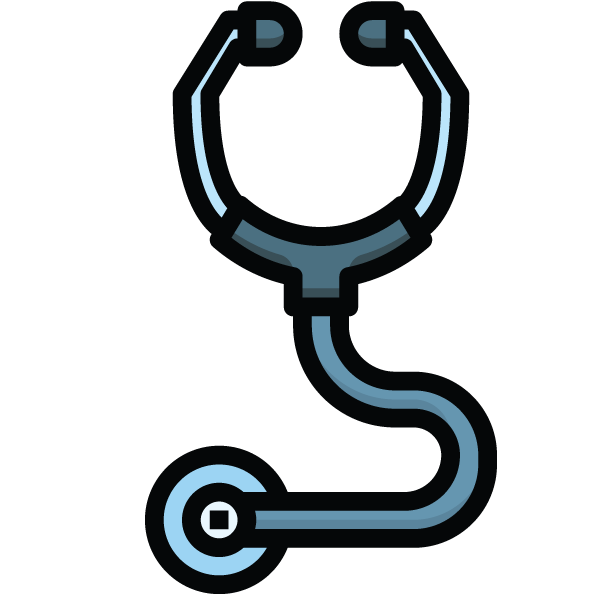
39
MEDICAL SPECIALTIES WHO PARTICIPATE IN THE ACO
From Primary Care to Cardiology, Cancer Care and beyond!
Adirondacks ACO Results
Even with a global pandemic, Adirondacks ACOs network continued to achieve goals and continued the high quality of care for our communities
Shared Savings
The goal of the Adirondacks ACO Model is to support our partner organizations as we move the health care delivery system from what we know as volume-based to value-based payments. Our network providers have the opportunity to maintain their independence while having the value of shared resources, data, and supports that will better prepare them for this shift in health care delivery. Providers have the opportunity to achieve shared savings when collectively we meet financial and quality goals that benefit the community as a whole. This way, we can ensure that patients, especially our most vulnerable community members with complicated health issues, have the supports needed and our network providers have the resources to do what is needed to make a difference in the community.
Adirondacks ACO Receives $5.1 Million in Shared Savings for 2020 Performance
Despite the impact of our region’s response to COVID-19, Adirondacks ACO providers focused on serving their patients and continued to provide high-quality care throughout the pandemic. As a result, for 2020, we received $5.1 million in shared savings, with 98% of the funds to be distributed to our participating provider network. The largest share of the savings, $3 million are from the Medicare Shared Savings Program (MSSP). To note, this is the first time in the ACO’s history that we have earned shared savings with MSSP.
Shared savings are not earned without also maintaining a high quality score for our beneficiaries. In 2020 we increased our overall Medicare Quality Score, which translates to receiving 39% of the possible 40% of the total savings available.
ADIRONDACKS ACO NETWORK GENERATED
$2 MILLION
IN ELIGIBLE COMMERCIAL AND MANAGED MEDICAID SHARED SAVINGS IN 2020
FIVE OUT OF
SEVEN
ADIRONDACKS ACO HEALTH PLAN ARRANGEMENTS HAVE SHARED SAVINGS
ADIRONDACKS ACO NETWORK GENERATED
$5.1 MILLION
IN ELIGIBLE SHARED SAVINGS IN 2020
TOTAL SAVINGS IMPROVED BY
$3.3 Million
Since 2019
ADIRONDACKS ACO NETWORK DISTRIBUTED
$4.8 MILLION
IN TOTAL SHARED SAVINGS IN 2020
%
Total 2020 Shared Savings Distributed to Our Network
Medicare Quality Score & Shared Savings Improvements
In the Care Coordination/Patient Safety domain, we earned 7.70 out of 8 points. There were strong improvements in the Risk-Standardized Acute Admission Rates for Patients with Multiple Chronic Conditions and Ambulatory Sensitive Condition Acute Composite measures. One area that did see a significant decline is Falls: Screening for Future Falls Risk measure went from 83.81 in 2019 to 77.15 in 2020.
In the Preventive Health domain, we earned all of the possible 12 points. The ACO made improvements in four out of the six measures. Influenza Immunization, Colorectal Cancer Screening, and Breast Cancer Screening saw significant improvement earning Quality Improvement Reward points. One measure saw a considerable decline, Screening for Depression and Follow Up Plan dropped to 74.64 in 2020 from 80.89 in 2019.
In the At-Risk Population domain, we earned 5.55 out of 6 points. In 2020 ACO providers made improvements in Controlling High Blood Pressure and Hemoglobin A1Cs but saw a significant decline in Depression Remission at Twelve Months.
According to the National Association of ACOs (NAACOS), overall, the Medicare Shared Savings Program ACO model served 10.6 million seniors in 2020 and collectively achieved $4.1 billion in gross Medicare savings and $1.9 billion after accounting for shared savings payments. They earned an average quality score of 97.8%.
%
2020 Total Quality Score
(3.7% Increase from 2019)
ADIRONDACKS ACO NETWORK GENERATED
$3 MILLION
IN ELIGIBLE MEDICARE SHARED SAVINGS (MSSP) IN 2020
The Adirondack Accountable Care Organization had a good year – continuing to mature in its role of improving and monitoring quality health care, enhancing cooperation among its partner providers, clarifying financial structure. We had financial success despite the effects of the pandemic. We were also able to make progress organizational development despite the demands on our providers. We continue to look to the future of health policy and to our partnerships with the payors.”
2020 Commercial Quality Snapshot
The pandemic of 2020 presented many challenges for our network providers, patients, and communities. These challenges impacted the healthcare community and how they delivered care. Practices quickly adapted to delivering care via telehealth, to ensure patients were getting their personal health needs met without putting them at risk.
The switch in how our Network provided care created workflow challenges and changes from billing, connectivity, and staffing challenges to name a few. As practices worked through these challenges, our Network successfully submitted and maintained our NYS PCMH recognition, along with increasing quality performance across the Network.
NETWORK EXPERIENCED A
6.5%
INCREASE
IN THE OVERALL COMMERCIAL PERFORMANCE OVER 2019
Increases are seen in colorectal cancer screening, childhood immunizations, and adolescent immunizations
SUCCESSFULLY
ADVOCATED
ADVOCATED ON BEHALF OF THE PROVIDERS FOR A TIERED APPROACH FOR QUALITY RESULTS
Obtaining points as the network achieved the 50th, 75th or 90th quartile based on NYS QARR benchmarks.
ADIRONDACKS ACO RECEIVED
SUCCESSFUL FIDELIS
PERFORMANCE
FOR 2020
With seven new measures in the VBP arrangement, which included two childhood immunization measures, monitoring diabetes post-partum follow-up, behavioral health, and SUD follow-up post ER.
Fidelis performance allowed the ACO to utilize the better of 2019 or 2020 performance due to the effects that the pandemic would have on our provider network.
2021 Quality Highlights
At Adirondacks ACO, we have continued on our positive trajectory for 2021. Although our Network has faced obstacles, we have collectively worked with our Network to ensure we can continue to see positive outcomes.

For 2021, Adirondacks ACO worked with the Commercial Quality Payer Committee to continue the tiered approach for Commercial Quality. The approach utilizes the NYS QARR benchmarks, allowing providers to receive credit for their improvement effots with fair and consistent benchmarking.

Adirondacks ACO in collaboration with Empire BCBS rolled out a six month pilot program to support the Healthy Steps program. Healthy steps is an evidenced-based, team based pediatric primary care model that promotes the health, well-being and school readiness of babies and toddler. The program allows the team to tailor support for the complex concerns the pediatrician lacks the time to address such as behavior, sleep, feeding, parental depression, SDoH, ACE’s and adapting to life with a baby and toddler. Healthy Steps will be piloted at Plattsburgh Primary Care and Mountain View Pediatrics.

Adirondacks ACO will also be working with network providers to assess their ability and readiness to move to electronic clinical quality measurement (eCQM’s), as CMS Medicare Shared Savings Program will require the quality submission to be via eCQM’s in the measurement year 2024.
Adirondacks ACO Partner Collaboration Programs
When working as an ACO, our care goals become apparent when we work together with our network providers and community members.
Northwinds Integrated Health Network Partners agree that working with Adirondacks ACO has been quite beneficial. The education received, and the relationships that have developed working with the ACO have improved patient outcomes, which is a goal that we all share. Our team has become part of multiple educational workgroups that focus on Practice Transformation, Community and Beneficiary Engagement, and Quality Improvement. Northwinds Partners and Leadership agree that working with Adirondacks ACO Network is invaluable for improving efficiencies and whole-person health.
National Alliance for Mental Illness – Champlain Valley (NAMI-CV)Partnership
To meet our shared goal of moving toward whole-person care, it is vital to expand our partnerships to include a range of providers. In 2020, Adirondacks ACO partnered with the National Alliance for Mental Illness – Champlain Valley (NAMI-CV) to provide supportive, certified peer services to our Fidelis attributed members in Clinton County. The HOPE Team (Healing by Overcoming obstacles through Peer Empowerment) has provided a range of services to augment the care management that many of our network partners offer in 2021.
Adirondacks ACO shared a list of 179 high-risk Fidelis members with NAMI. They provided out reach services to identify barriers and supportive efforts needed to assist with with removing barriers in their care and home life. Since sharing the list, we collectively see a positive impact on the partnership.

National Alliance for Mental Illness – Champlain Valley (NAMI-CV)
Snapshot
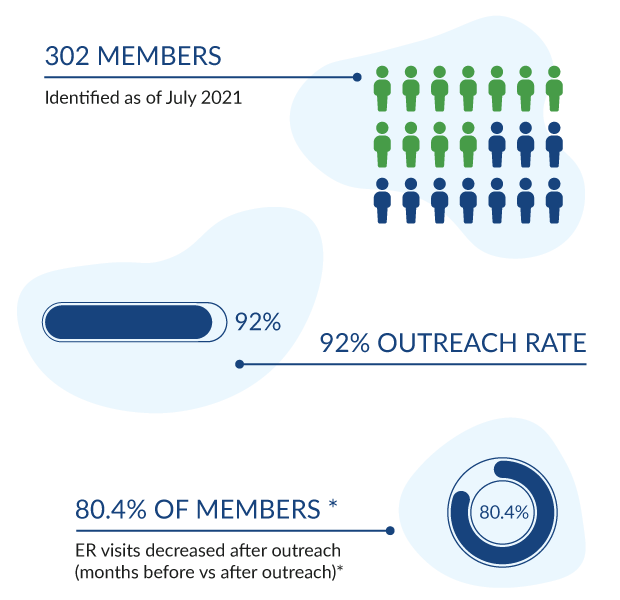
Met the SDOH criteria
Engagements with members
Engagements per member
Need SDOH assistance
Living in temporary place (Shelter, Motel, transitional Housing)
Found with different phone numbers and addresses
* Denominator: People who had ER visits 6 months prior to the outreach date; people with unknown outreach date is not included
Northwinds Integrated Health Network: Connecting Data & Quality Improvement
At Adirondacks ACO, we continue to strive to provide our provider network with data, resources, and tools that can improve patient health. One project that will be the main focus for the ACO for 2022 is a Behavioral Health Dashboard. We feel that by sharing information and working together with behavioral health, our network providers can do even more to give the best care to our communities and use this as a Stepping Stone to achieve Physical & Behavioral Health Objectives.
Northwinds Integrated Health Network and Adirondacks ACO are excited to be working with Monroe Plan on a data infrastructure project to build a dashboard to create comprehensive data acquisition, integration, analysis, and tracking of physical and behavioral health data points, including gaps in care. This Dashboard will allow us to identify populations in need of services and general gaps in care, establish a VBP contract baseline, link clients to needed services, improvement in health and wellness of clients (lower cost of care, decrease ED utilization- translates into shared savings). The Dashboard includes a stream of data from multiple sources to which the ACO has access. Fidelis has also just been given approval from their compliance team to share aggregate level CCBHC encounter data, including the servicing CCBHC by month, count of membership, and distinct visits for your attributable population. Fidelis is reviewing the report to update for any additional service months and will be sharing it with the ACO.
Additionally, there are ongoing discussions regarding clients’ attribution to outline better provider responsibility, a workflow of patient access, and best engagement strategies and assignment of risk stratification.
The following steps include a soft rollout of the Dashboard to a few Northwinds Integrated Health Network providers and providing training on dashboard use, ongoing engagement to review measures, and a section of measurement priorities.

Adirondacks ACO
Network Participants
Adirondacks ACO is an Accountable Care Organization (or ACO) made up of groups of doctors, hospitals, and other health care providers, who all work together to deliver high-quality, coordinated care.
COVID-19 Reflection: A Personal Retrospective
By Dr. Wouter Rietsema, Adirondacks ACO Chief Medical Officer

I feel at times like this pandemic will never end. The national media relentlessly chases clickbait but rarely takes a big picture view. But then I take a deep breath, step back and look at some of the important achievements of the last 12 months.
November 2020, the first monoclonal antibody (MAB) was approved for early disease in high-risk individuals to reduce hospitalizations and death. On December 15th, 2020, the first doses of a COVID vaccine were given. Now over 75% of New Yorkers are vaccinated. Lastly, in the last six weeks, Merck and Pfizer submitted applications to the FDA for COVID pills which reduce hospitalizations by as much as 89% if given within the first three days of symptoms.
It isn’t all bad.
This pandemic has been draining and dispiriting in so many ways, and yet there are always silver linings when I take the time to see them.
Healthcare is really, really hard right now. I am so grateful for an incredible team at CVPH and every provider of healthcare and social services across the Adirondack region. They are all tireless, courageous, and dedicated every day. I am grateful for my new public health colleagues across the North Country who contact trace, vaccinate, and still do their “day jobs” with grace, professionalism, and dedication. They are an incredible pleasure to work with. I am grateful that my youngest son and his girlfriend survived an endless DC lockdown in a minuscule basement apartment still together and in love, and they got engaged this summer! And my daughter found love during the pandemic and got engaged over Thanksgiving! Lastly, I didn’t learn sourdough baking during the pandemic – I already knew how and I baked a lot and refined my skills. Now I am learning to bake cookies – especially a spiced rye molasses cookie. They are really good!
What do I see today with COVID?
At this time last year, we were in the midst of a COVID surge over the holiday season that, at its peak, would cost over 3000 Americans their lives each day. In NY, where over 75% of the population is vaccinated, the Delta and now Omicron surges have been sustained and full of cases, but deaths have risen far less – and are concentrated in the unvaccinated. Vaccines remain 90 – 95% effective at reducing hospitalizations and death, even with Delta. And boosters are now widely available for all Americans after five months. Monoclonal antibodies reduce hospitalization, but our choices have narrowed with poor availability, especially with Omicron. They are also intravenous medications and health systems are too stretched to get them to all who are eligible. Pills have been approved but remain very hard to come by.

What about the winter and the rest of 2022?
Crystal balls in COVID have proven unreliable, but there are reasons to be optimistic. The wide availability of a pill should be a game-changer, although it is unclear when we will see enough supply during the year to make a difference. Imagine calling your provider at the first onset of symptoms and picking up a five-day prescription at the pharmacy. It is quite possible that these pills will also reduce transmission of COVID, although there are no studies of this yet.
Boosters are widely available and will continue to reduce hospitalizations and mortality. Lastly, we have only just begun to vaccinate children below 12. It has become clear that school-related cases are a potent Delta driver. Vaccinating children will have an increasingly positive effect on case numbers over the next few months.
Omicron is the new variant that is creating chaos. Let’s review what we know. Vaccination and boosting continues to prevent severe disease quite well and milder infection less well. On a percentage basis, Omicron causes significantly less hospitalization and death. Unfortunately, its extreme infectivity and explosive spread still threaten our healthcare infrastructure in the short run. Eventually, we may develop enough of a vaccine/natural immunity foundation that significantly lessens the severest impacts of the epidemic, hospitalizations, and death. I wonder if Omicron may become a positive turning point in the long run – a highly infectious but less morbid variant that becomes the dominant strain.
Over the long term the combination of increasing vaccination, oral therapies, and increasingly less morbid variants should help us move from a deadly pandemic posture to one where COVID is just one of all sorts of risks we face on a daily basis. We must all do our part to get there. Get vaccinated, get our kids vaccinated, keep the mask for when required or appropriate, and start to imagine a different life. It will not be easy. I still worry about new variants, and even more, I worry about the after-effects of this pandemic for years, if not decades to come. My resolution for the next 12 months is not to let fear and worry consume me but to search for and enjoy every moment of community and light with my colleagues, my friends, and my family while I keep putting one foot in front of the other, like all of you do every day.
Adirondacks ACO
Board Members
Adirondacks ACO is governed by a Board of Managers that provides oversight of the services needed to fulfill the Quadruple Aim: “Improve the Quality of Care, Increase Patient Satisfaction, Lower the Cost of Care, and Increase Provider Satisfaction.”
Adirondacks ACO’s Board of Directors includes providers from all sectors of our regional health care system, as well as local residents who represent Medicare and Medicaid beneficiaries, and an individual who advocates for the uninsured. These individuals actively participate in board meetings, provide community input and guidance, and vote on all matters that come before the board.
Adirondacks ACO 2022 Opportunities : Minimizing The Impact
The on-going impact of the response to the pandemic continues to stress our provider network partners on many levels. Our focus in 2022 will be to maintain the current PMPM levels – providing some financial support for enhanced patient supports; minimize additional downside risk with our payer contracts as much as possible; and ensure that we provide supports to our network partners that improve their opportunities, not add additional stresses
Financial: Adirondacks ACO Funds Flow
The Adirondacks ACO continues to ensure that PMPM funds flow to our participating primary care providers on behalf of our payer partners. The ACO administrative costs continued to be carefully monitored to ensure that only a fraction of the total PMPM is needed to support our infrastructure.
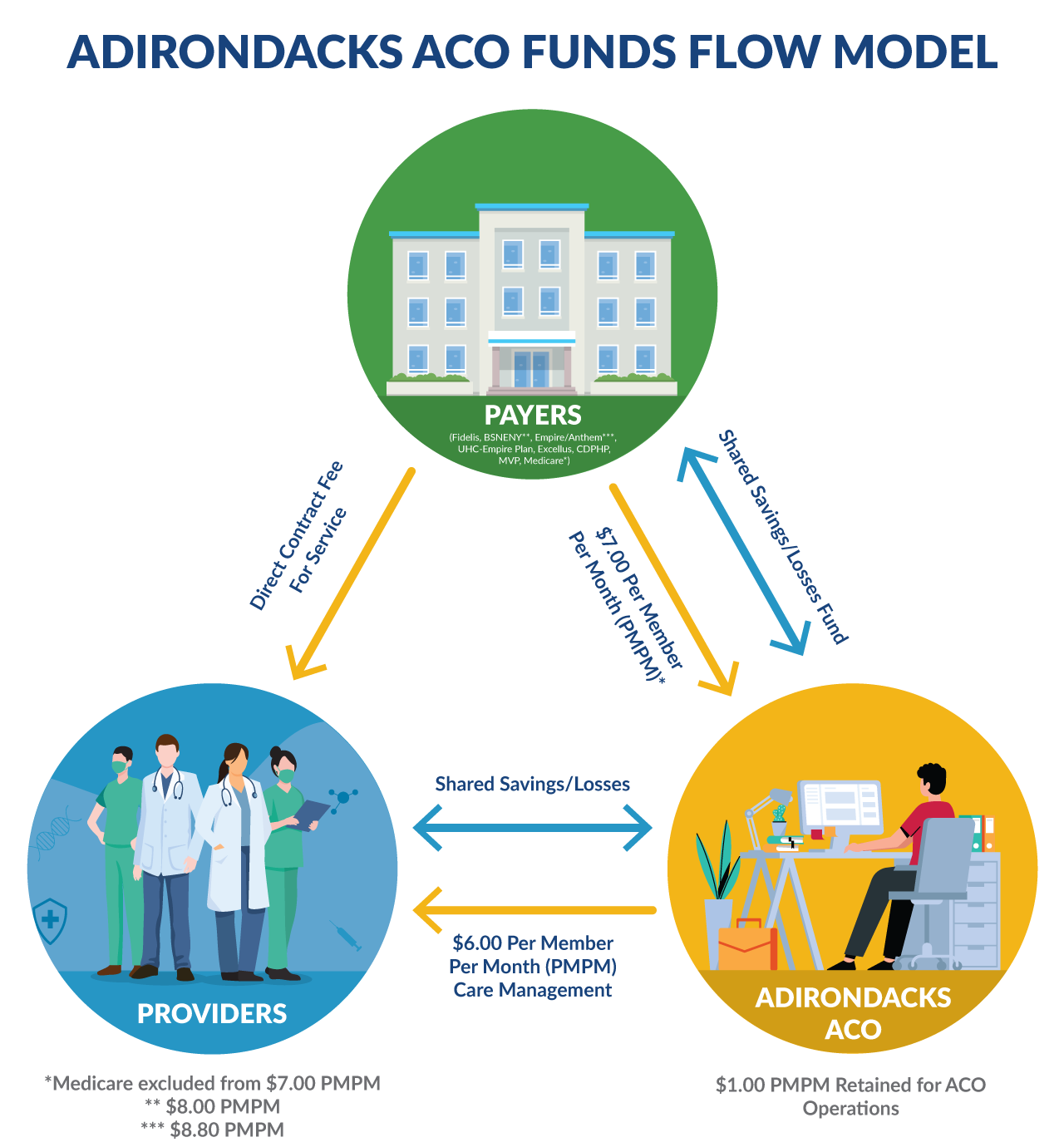
2022 Contracting Strategy – Stay The Course
The ACO Leadership consciously decided to approach 2022 contracting with a “stay the course” theme and minimize any additional burden to our network providers . We approached each health plan with the intent to maintain their 2022 contract with the same expectations and shared savings/shared risk parameters as we had in 2021. This approach would also include the continuation of the PMPM funds that were received in 2021 and in prior performance periods.
We were successful with our approach and with the exception of one plan, maintained our 2022 contracts without additional risk to our participating partners. This strategy outlines our guiding principles for 2022 and focuses on three focus areas –

Financial
Maximize provider incentives while mitigating downside risk
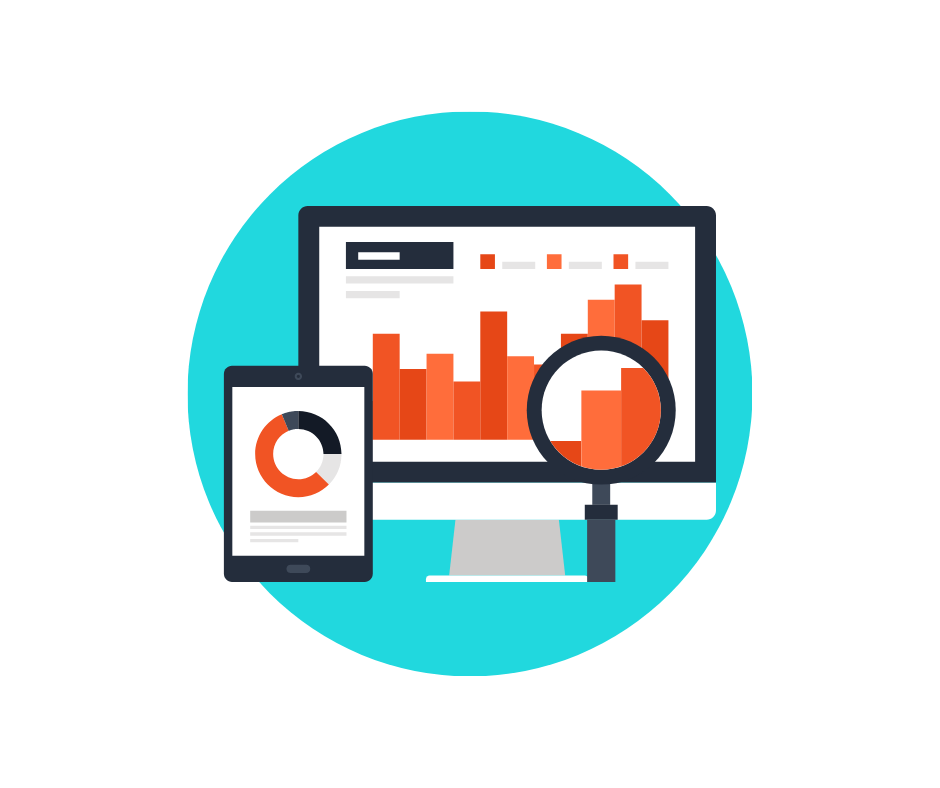
Quality & Data
Align metrics and data reporting across all payers and reduce the administrative burden for each provider organization

Network & Community
Maximize attribution and expand support for Community Based Organizations that enhance ourMental Health and Substance Use Disorder/Primary Care Provider Integration
We added a new payer agreement for 2022 based on an employer group shift in coverage and we received notification from one payer with their intent to terminate based on their organizational approach to payment reform.
Additionally, the 2022 citizenship criteria was developed based on what we have learned from the two prior performance periods and offers more opportunities to value the work of our partners in the region – based on the ACO resources available. This philosophy is also based on our intent to “stay the course” for 2022.
Adirondacks ACO Data and Performance Tools
At Adirondacks ACO, we strive to foster a positive collaboration with our Network to ensure that we can give our community access to healthcare no matter where they receive it.
Electronic Clinical Quality Measures (eCQM) Reporting
Adirondacks ACO and Adirondack Health Institute are preparing the ACO to move to electronic clinical quality measures (eCQM’s)reporting. The current process of quality submission to CMS via the web interface is a sample of approximately 2500 unique patients, which is a manual process for the ACO and providers in the network. CMS has decided by 2024, ACO’s must submit via eCQM’s and is focused on the entire panel of patients that meet the criteria for inclusion in a measure. It is expected that all electronic health record systems (EHR’s) can produce patient information in structured files using the Quality Reporting Data Architecture (QRDA) concept. The data analytics team is building the capability to receive QRDA files from disparate partner EHR systems. The team has identified that reports are not created equal across vendors, there may be costs associated with turning on the reporting capability and the aggregation of these reports across the network is complicated. Once implemented, this capability can free up valuable time for clinicians/support staff and let our partners focus on patient care.

High Emergency Department (ED) Utilizer Report
While many people only consider going to the emergency room in very urgent situations, emergency room high utilizers are a completely different scenario. Research often finds this population with extremely high overall health care spending, multiple co-morbidities, unmet need for social determinants of health, or unmet need for care management. In addition, many of these ER visits could be treated in primary care settings or nonemergent care. Primary care physicians can play a vital role in improving the care coordination for these individuals and eventually improving their quality of life. However, we are often seeing a lack of communication between the emergency rooms and primary care practices instead. In some situations, data is not shared back to the primary care offices or only available in a specific payer’s portals, not others.
To provide our primary care practices, a comprehensive view of their attributed patients’ ED history, Adirondacks ACO’s data team creates a report that focuses on the individuals with more than five ER visits in the rolling 12 months. This report consolidates multiple data sources (claims and payers’ care portals) into one single format from seven payers, including Fidelis, Medicare, Empire BCBS, Excellus, BSNENY, CDPHP, and MVP. This way, providers will not need to look up multiple places to get the same information.
The report contains two parts, first is the ER visit details, including the service dates, the top 3 diagnoses, and the ER facility name. The second part provides more information on the individuals’ care information, including health home enrollment status, primary care utilization history, chronic conditions flag (COPD, diabetes, health failure, behavioral health, etc.), contact information, and payer-identified opportunities. Practices can utilize this report to identify individuals that might need health home or care management services or identify patients that haven’t connected with primary care for a while and schedule a follow-up.
In addition to sharing this report with the primary care practices, Adirondacks ACO also shares this information with our collaborated community-based organization – NAMI, so that they can help outreach to those individuals who might need more than just medical care services. We believe this report can bridge hospitals and primary care practices and reconnect patients with their primary care services.
Social Determinants of Health (SDoH) Report Preview
We’ve been hearing about the importance of social determinants of health (SDoH) for years: The World Health Organization Global Commission on the Social Determinants of Health published a report in 2008, showing that social factors (education, income, employment, family circumstances, etc.) are at the heart of inequality in life expectancy, and subsequent research shows SDoH impact diseases from cancer to COVID-19.
In this new report, we look at ACO member claims for SDoH from the past 12 months, including problems related to literacy, education, employment, income, family, upbringing, social environment, housing, pregnancy, incarceration, neglect, and abuse. Our aim is to illuminate and summarize SDoH claims for our providers so they might have a more complete picture of their patients’ needs.
Where a person lives is closely related to SDoH and – by extension – health outcomes. This report includes a snapshot of the ZIP code map of claims for each member organization (“TIN”) to show approximately where their patients with SDoH claims live. With the help of this map – and future improvements to it – we hope individuals might be linked more easily with nearby services.
The SDoH report includes four parts, as follows:
SDoH TIN Summary
- The top five SDoH by count of claims: Which codes (or categories of codes) were used in the most claims?
- The top five SDoH by count of individuals: Which codes (or categories) were assigned to the most patients?
- The top five providers who assigned SDoH codes to your patients: Which providers diagnosed the most patients?
All SDoH claims: All SDoH claims for the TIN’s patients during the most recent 12 months, including claim date, SDoH diagnosis and servicing provider, as well as most recent office visit date, provider & location.
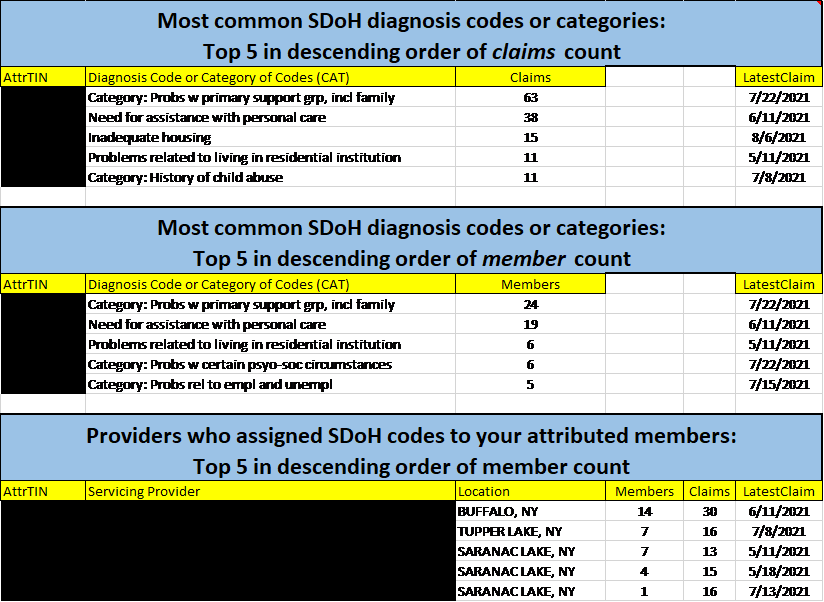
Map of SDoH Members by ZIP (Shown below): A static map of the ZIP codes where the TIN’s SDoH patients live, including diagnoses found in each ZIP. Specific claims by ZIP code are included in the actual report.
Most common code by member: The TIN’s SDoH patients, in descending order of the number of SDoH claims. This includes the SDoH code most often used for each patient, date of service, office visits, patient’s ZIP code, and more.
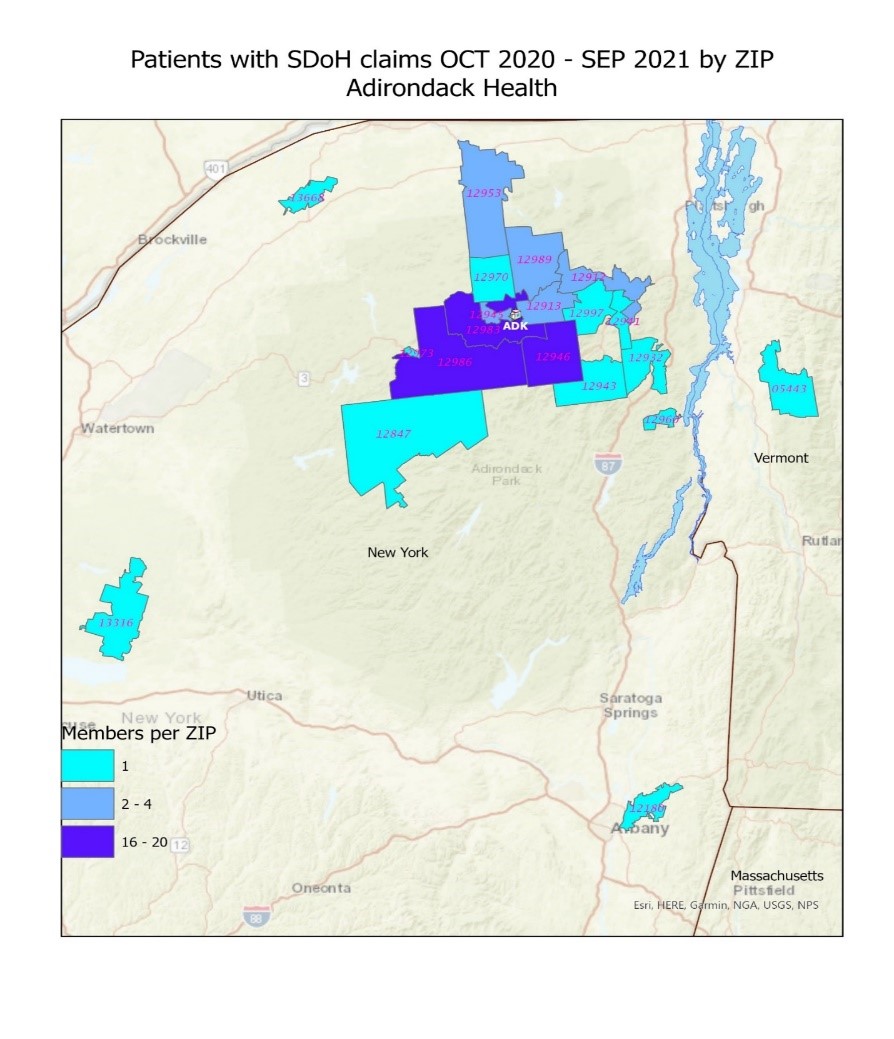
The Wellness Visit Report
The wellness visit – and preventive care in general – is a central tenet of the ACO. One of our collective goals is to keep our members current with regard to vitals, screenings, health risks, advance care planning, and quality metrics through yearly wellness visits. The ACO data team has developed a new Wellness Visit Report to help providers see who among their patient panel needs a visit scheduled, and who might have coding gaps for the calendar year. The report draws upon our claims database for all ACO members, ages three years or older.
Providers have recently received the first version of this report. It includes lists of their attributed patients who are either due for a wellness visit in the next six months or haven’t had one in more than 12 months. This portion of the report could serve as a “call list” for office staff. The report displays a flag if the patient has had certain chronic conditions coded on a claim in prior years but hasn’t yet this year. These flags could act as reminders during an upcoming wellness visit.
This report is not intended to offer clinical guidance, encourge diagnosis “up-coding,” or in any way suggest which codes healthcare providers ought to use with their patients. The data team hasn’t employed machine learning, but has simply compared claims with certain diagnosis codes from past years to this year. As with all reports we produce, we hope the Wellness Visit Report is the beginning of a conversation with providers so that we might better support their work.
The Wellness Visit Report includes three parts, as follows:
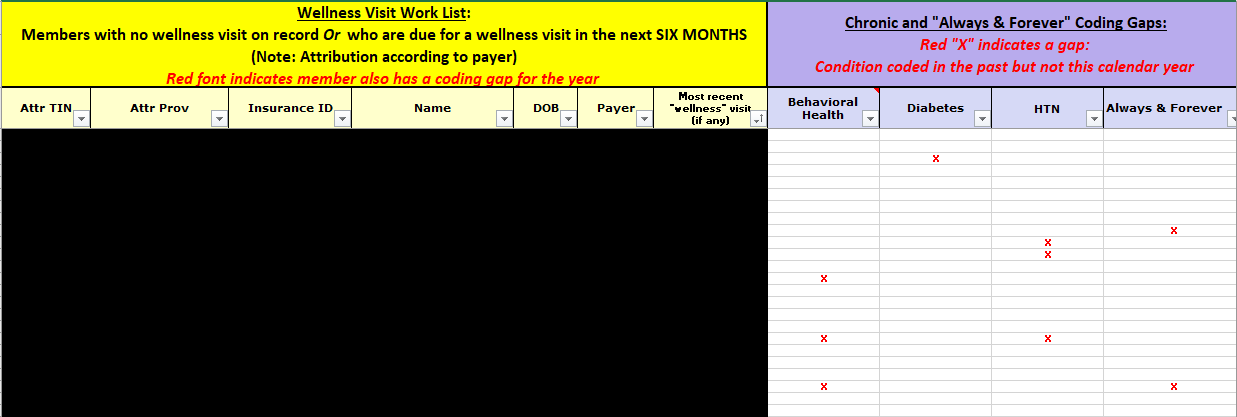
Wellness Visit Work List and Chronic and “Always & Forever” Coding Gaps
The yellow section shows the TIN’s attributed patients who are due for a wellness visit, and those due for one within six months (for planning purposes). We’ve included the most recent wellness visit claim date if we know it. The purple section displays an “X” for chronic conditions that have been coded in past years but not coded this year; we’ll be adding more conditions to this section in future editions of this report.
Codes Used in Report
Peeking under the hood of this report, we’ve included a tab with all the HCPCS, CPT and ICD-10 codes we used in the analysis, and what each signifies. These are the codes we looked for in the claims to indicate that certain conditions or encounters with the provider have occured. We welcome input from our providers as to which codes we should include
Gaps Work List
The orange section lists patients who are current with their wellness visit, but have at least one chronic or “forever” code missing this year. The purple section is as described above. Note there’s no overlap of names between the yellow list and the orange one.

Citizenship Criteria: For 2021 Performance Year
2020 was the first year the ACO monitored and measured citizenship criteria with the intent to apply results to our shared savings and losses
In early 2021, the ACO Board of Managers made the very conscious decision – based on many factors related to the pandemic – to hold all ACO Provider Network partners harmless from the impact this criteria. This decision coupled with successful shared savings opportunities resulted in more funds being distributed directly to our ACO partners for performance year 2020.
The 2021 citizenship criteria was approved in late 2020 and throughout the year, we have monitored this criteria closely. In mid July, we provided a performance snapshot to each Provider group, with detailed opportunities to ensure success for the performance year. As we reflect on the full year and continue to “tally” the results, we have seen much success as well as some unintended challenges.
Quality improvement plans are consistently developed with all ACO Partners and opportunities for participation in quality meetings and on-going education forums have provided support to the region’s partners. The North Country Care Coordination Collaborative (funded by a HRSA grant received by CVPH on behalf of the region) has had a very positive impact on improved transitions of care planning. As partners across the region participate in the collaborative, they are also successfully meeting key elements of the citizenship criteria.
Our unintended challenges have not had a negative impact on care, however the challenges do limit adherence to the prescribed criteria. As the year progressed, we recognized that access to adequate claims data for our BH/SUD partners would impact their ability to close gaps in care to support our quality measures reporting. This lack of adequate data also prevented our BH/SUD partners ability to identify consistent coding practices, which ultimately impacts our overall risk score.
While these challenges are being resolved, we do recognize that our partners have consistently worked to support initiatives that will improve the consequences presented. Our BH/SUD partners consistently participated in focused monthly sessions that support quality improvement process development for their organizations members. Primary Care providers submit gap closure directly to some payers – and credit will be given for these efforts. Access to adequate data is an on-going discussion with each of our payer partners and continues to improve over time.
Adirondacks ACO Staff
Adirondacks ACO team is made up of various individuals who believe in a common goal of wanting a healthier community.
In a time of stress and uncertainty in the world, I feel so lucky to work for the ACO. The many wonderful people who share a common goal — to support the wellness of mind, body & spirit in our region — makes me feel like I’m part of a tight-knit neighborhood called the Adirondacks.

Eric Burton
Interim Chief Executive Officer (CEO)
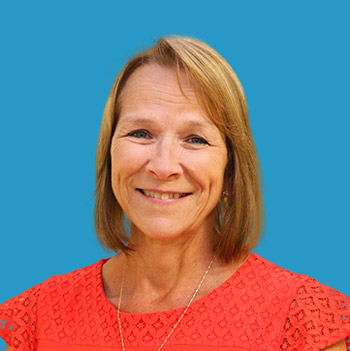
Karen Ashline
Vice President

Wouter J. Rietsema, M.D.
Chief Medical Officer

Justin Frazer
Compliance Officer

Katy Cook
Director of Partner Engagement
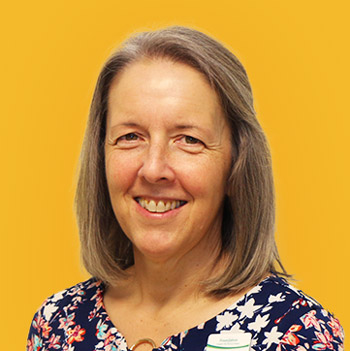
Brenda Stiles
Director of Clinical Quality Improvement and Practice Transformation

Laura Morris
Director of Data Analytics

Meg Henning
Project Manager
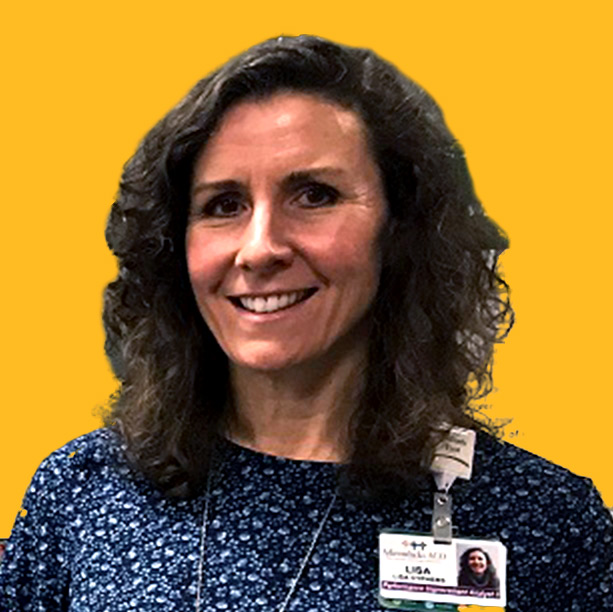
Lisa Cyphers
Senior Performance Improvement Analyst

Lilian Wu
Program Performance Analyst

Melissa Joyce
Support Specialist

Tyler Babbie
Accountant
Adirondacks ACO
Insurance Plans
Adirondacks ACO serves as the provider network for government-sponsored and commercial insurance plans called “payers” that are available to New York residents. By partnering with an ACO like us, government and commercial payers can offer affordable insurance products where the provider network is motivated to deliver quality care at a lower cost, which benefits the patient, the payer, and the provider.
